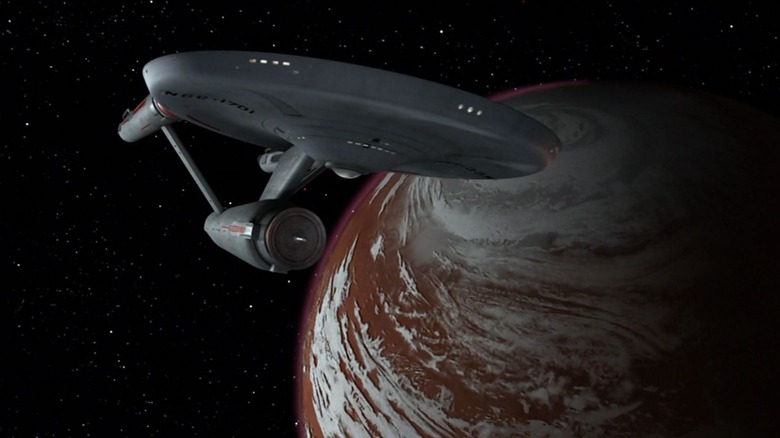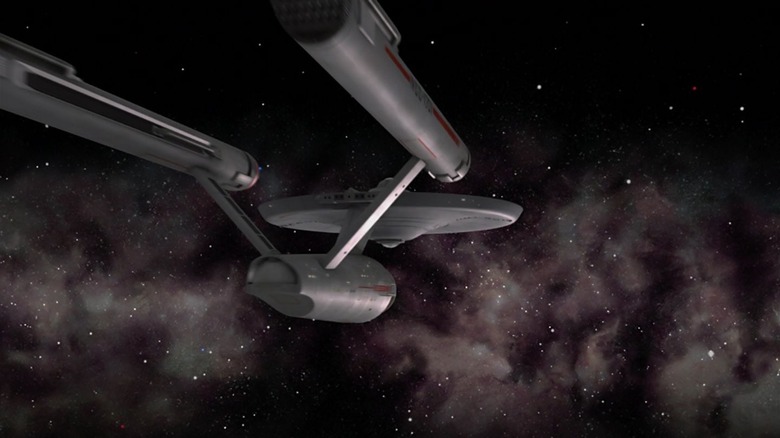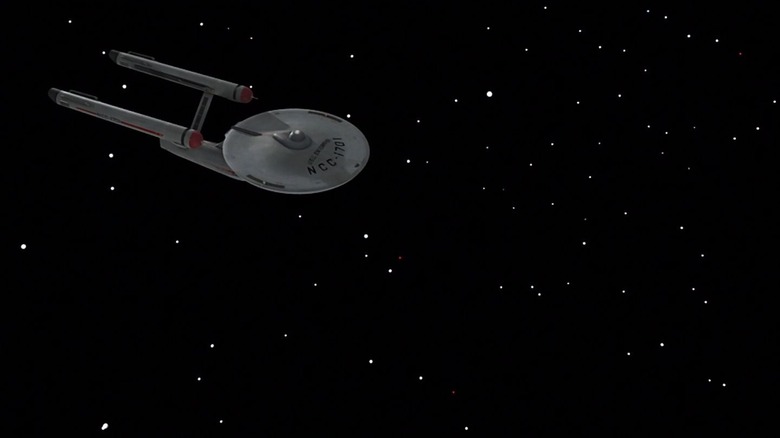How Much Would It Cost To Build The Starship Enterprise From Star Trek?
Within the universe of "Star Trek," we actually know exactly how much it cost to build the U.S.S. Enterprise: exactly zero dollars and zero cents. "Star Trek" takes place in a post-capitalist utopia wherein money has been dispensed with. Everyone still works, but it is to better themselves, to better society at large, or to serve others they care about. Thanks to miracle technologies like faster-than-light engines and replicators that can summon food out of thin air, no one wants for anything, and citizens are free to pursue their passions. If you want to farm kumquats, you may farm kumquats. You may have to move to a planet that has the room to do so, but it can be arranged for you. Capitalists and collectors are villains.
So it goes with starship construction. Starfleet vessels are built at a facility called Utopia Planitia, which orbits Mars, and ships are (presumably) constructed out of specially mined ores, specially constructed computers and engine parts, and salvaged pieces of other recycled ships. The people who build the ships only focus on making the best ship possible, and equip it with the best possible tools for its designated missions; a research vessel, for instance, would have better scanning equipment. A transport vessel would have more room for passengers.
We here in the 21st century, sadly, still live under the yoke of capitalism, and making an actual Starfleet vessel like the U.S.S. Enterprise would cost a great deal of money. Also, since we don't yet have a Utopia Planitia ship-building facility in the present, we would also need to worry about the cost of manufacturing the materials needed to make a starship using modern means. Plus, there's the issue of taking the pieces up into space where they can be assembled.
This ship is going to run a pretty penny.
How much raw material would be needed to build the Enterprise?
The Enterprise as it was seen in the original "Star Trek," was about 288 or 289 meters long, or about 948 feet (according to various fan websites). A comparable vehicle made on Earth in modern times might be an aircraft carrier. According to the website Largest.org, the world's biggest class of aircraft carrier is the Gerald R. Ford class, which is actually longer than the U.S.S. Enterprise at 337 meters, or 1,105 feet. A vehicle of that size costs the U.S. government $12.998 billion to build, making it the most expensive warship in naval history. The Gerald R. Ford needed to be watertight, although more would likely be required to make the Enterprise airtight and suitable for space travel.
A Gerald R. Ford-class ship is a lot longer than the Enterprise, but the Starfleet vessel is a lot taller and is a much spindlier vessel. Let's assume that the raw materials to make the Enterprise are about equal in modern dollars. Of course, we don't know the weight, the density, or the volume of the fictional metals that the Enterprise is made out of in the "Star Trek" universe, so we'll have to fudge a lot of this.
Something that does need to be considered, though, is how much it would cost to transport the Enterprise's raw materials into space. If you think it costs a lot to build an aircraft carrier on the Earth's surface, imagine needing to launch every ounce of it into orbit using rockets. Let's also assume for the time being that our Enterprise is being built in orbit around Earth, and will not need to be taken all the way to Utopia Planitia around Mars. How much would it cost to launch an aircraft carrier into space? A heck of a lot more.
How much would it cost to launch all the pieces of the Enterprise into space?
In J.J. Abrams' 2009 "Star Trek" film, it was established that the U.S.S. Enterprise was being built on Earth, presumably intended to have fully operational engines before taking off. This was not accurate to other "Star Trek" lore, and also took place in a parallel universe, so we'll ignore that detail for now. Let's assume that we have to launch everything with a rocket.
According to the website
, the Pegasus XL rocket, launched in 2023, cost $165 million to launch. That rocket could lift about 976 pounds, and weighed, by itself, about 51,000 pounds. This means it cost — if it was fully loaded up to 51,976 pounds — $3,174.54 a pound to launch. The weight of a Gerald R. Ford-class aircraft carrier (and we're assuming the Enterprise would weigh just as much) is about 100,000 tons, or 20 million pounds. Multiply that by the $3,174.54 a pound, then it would cost about $6,290,800,000 to launch the pieces of the U.S.S. Enterprise into space. That's in addition to the nearly $13 billion it would take to build. Money Digest estimates that there is about $83 trillion on the planet Earth right now, so we have plenty of cash.
Of course, this is just how much it would cost to build a machine the size of an aircraft carrier and launch it into space. This doesn't account for the price of unknown elements (transparent aluminum, warp conduits, gravity generators, photon torpedoes, etc.), nor the cost of stocking the Enterprise with food and drink — and air — for its 430 crew members. The website Redshirts Always Die theorized that maintenance on a machine like the Enterprise, using modern Earth dollars, would cost about $7 million a year. If "Star Trek" were to slip back into capitalism, and the Starfleet crew members were to get paid for their service, then one could tack on another $6 million annually.
Of course, $13 million a year for a space mission is actually cheaper than running the ISS.


